The Pentacon Six
System
by TRA
Is the Pentacon Six
too big?
Someone wrote to me, “I didn’t expect the
Pentacon Six
to be as big as this.”
Is it too big?
Well, if you must have a small
camera,
the Pentacon Six is not the one to go for. Nor is the
Hasselblad
500 series. Nor the Pentax 67. Nor many other
leading film-based
medium format cameras.
But if you want a camera that will give you maximum
quality
at a sensible price, then the Pentacon Six
might be
right for you.
We have recently got used to tiny cameras or even
to using
our mobile phone (US: cellphone) as a camera. This can be
great for
certain purposes, such as:
-
low-resolution web images
-
screen-based viewing (whether on a phone or a
computer)
-
small-sized files
-
e-mailing snapshots to friends.
However, you won’t find a wedding photographer, a
news photographer,
a landscape photographer – or any
professional photographer
– using a mobile phone for their normal professional,
money-earning photography.
Most of these have switched to digital – although
you
might be surprised at how many still carry a
film camera
as backup, and indeed how many landscape photographers, for
instance, still
shoot using film.
What sort of digital camera will these
professionals use?
For most of them, most of the time, the minimum
is
a full-frame DSLR. This means, a digital SLR with
a sensor
size of 24 × 36mm – the same size as the film frame in an
“old-fashioned”
35mm film camera. The best of these can produce images
that seem
to approach the quality of a medium-format film camera,
so long as the image is not enlarged too much.
(Photographers producing
images for point-of-sale, which might be printed several
meters
high, will need to use at least a medium format DSLR,
such as the
Hasselblad H4D-200MS, which is currently, in January 2013, on
offer in
the U.K. for only £26,395.00, body only – lenses extra, a lot
extra!)
But here I am not comparing the Pentacon Six with
a medium
format digital camera, but with the digital equivalent of a 35mm
format
camera, a “full-frame” DSLR. So in the contest to see
which is smaller
and lighter, the digital camera should win “hands down”,
right? Wrong!
I have chosen here the Sony Alpha A900, but
full-frame
DSLRs from each of the other major manufacturers (principally
Canon and
Nikon) will be of similar size and weight.
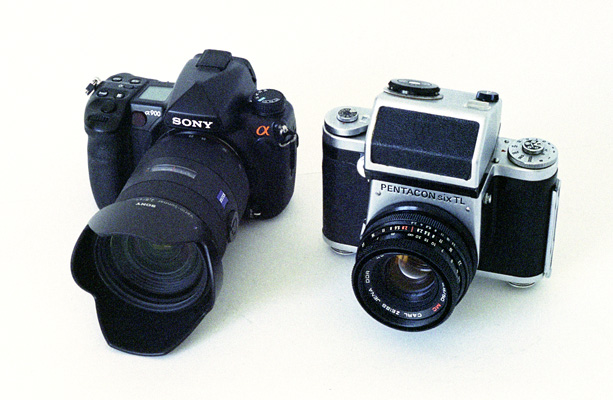
The Sony A900 with the most
commonly-sold lens for it,
the 24-70mm Carl Zeiss zoom.
The Pentacon Six with its metering prism
and standard
80mm Carl Zeiss lens.
One of the surprises is that the sizes
are so similar,
even excluding the lenses.
[c471_5a.jpg]
|
|
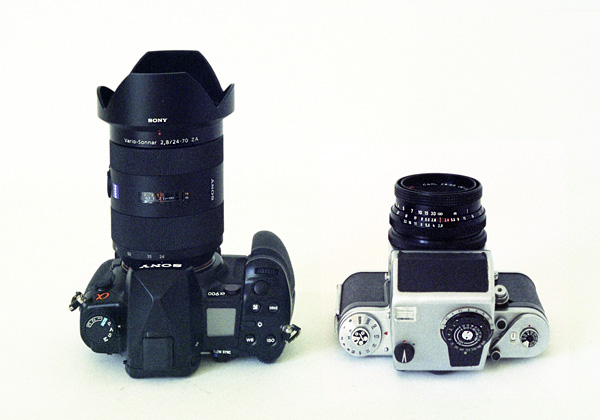
Working view of the two cameras,
although of course,
like all digital cameras,
the Sony A900 also has numerous controls
on the back.
Having a zoom lens may add flexibility,
but it also adds a lot of bulk and
weight.
[c471_6a.jpg]
|
| Vertical
grip
One of the advantages that we mentioned
(here)
of a square format camera is the avoidance of
compromises about the best
location of controls. Manufacturers of digital
SLRs realise that
holding their camera rotated for vertical images
(so-called “portrait
mode”) may be uncomfortable and it may be
difficult to operate that
way round. For a professional who works hours
with a camera day after
day, this can even result in muscle problems for the
wrist. (Think
of news photographers, most of whose shooting is done
hand-held.)
The solution has been to produce a grip
that enables the
camera to be used rotated, replicating some or most of
the controls.
One of the best of such grips is the one produced by
Sony, with the principal
controls being located in the same equivalent position
as the standard
controls on the body itself, when it is held
horizontally. (But check
out the cost of the vertical grip. It’s likely
to be more than the
cost of a Pentacon Six in mint condition!)
Sony also made a major design slip-up
with this grip:
illogically, it has a tripod socket on its “base”,
i.e., on the right-hand
edge when it is used in the orientation for
which it was designed!
Logically, the tripod socket should have been on the
left-hand vertical
surface of the grip, which becomes the new base when
the camera is used
in vertical format. If you are exploring a
digital system with a
vertical grip from any manufacturer, it would be worth
checking whether
the tripod socket is in the correct place for
tripod-based portrait
shots, which must be another major usage
envisioned for the camera
in “portrait mode”!
Battery
life
Another purpose of these grips is to
increase the time
that the camera can be used without needing to change
or re-charge the
battery. This Sony grip takes two standard Alpha
900 batteries, which
are automatically used one after the other. Some
grips from other
manufacturers take standard battery cells.
Of course, all functions of the
Pentacon Six perform normally
without batteries, and in my experience the battery in
the metering prism
lasts for at least two years, though with daily
professional use, it would
probably need replacing sooner. However, if you
use the camera that
much, you are likely to know the shutter and aperture
combinations that
will give you the results that you prefer, so you can
go on shooting with
the Pentacon Six, even if the meter stops working.
|
|
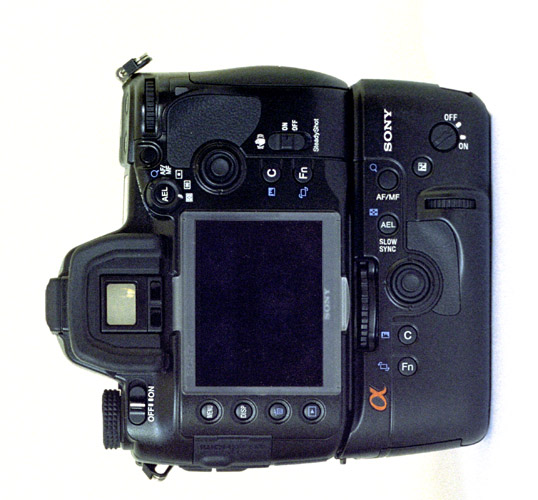
The Sony A900 with its vertical
grip/battery holder
[c474_26v.jpg]
|
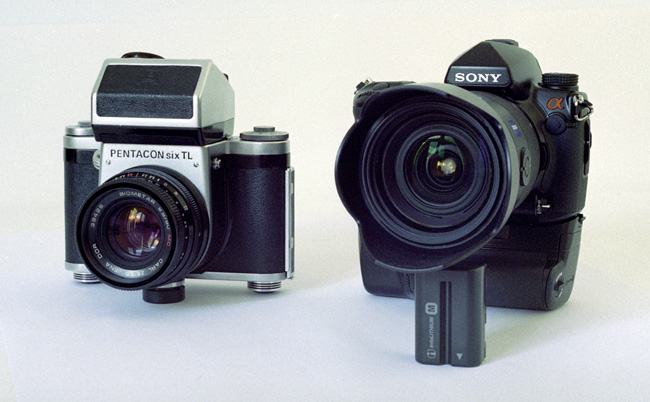
The vertical grip/battery holder of the
A900 adds greatly
to the height (and weight) of the camera. The
standard zoom lens
also makes it front-heavy, so for this picture I put a
spare A900 battery
under the front of the lens.
[c474_23.jpg]
|
|
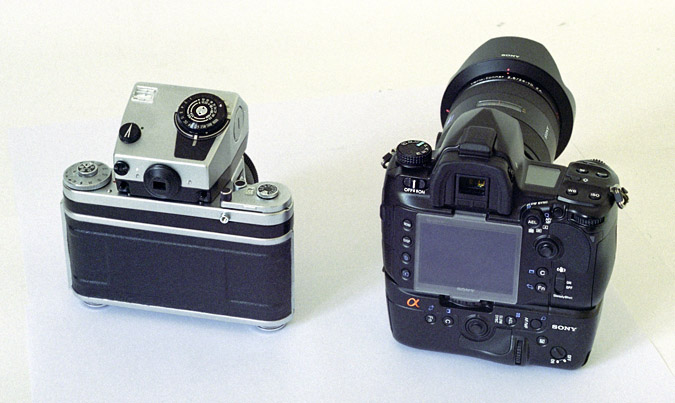
The side that faces the photographer.
The Sony Alpha A900 with the vertical
grip is clearly
a lot larger than the Pentacon Six.
[c474_25.jpg]
|
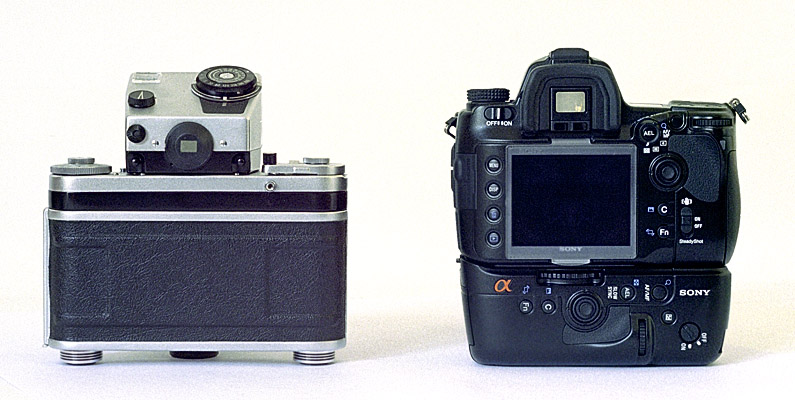
Looking straight at the back of the two cameras,
photographed
side by side,
gives a clear indication of the comparative
sizes.
[c474_26.jpg]
Perhaps the Pentacon Six
isn’t
so big, after all
If you are looking for a camera that will give
you:
-
high resolution images
-
beautiful gradation in the toning
-
professional-definition portraits, landscapes,
architectural
shots and much more
-
the ability to produce high-quality prints
-
full control over the factors that affect the
image (lens
aperture, shutter speed, focal length, etc)
you are likely to end up with a camera that is at
least this
size. It will not fit in your coat pocket for that
unexpected situation.
It is not a camera that you will casually carry with you
everywhere.
It is a camera that you will get out and take out when your
objective is
to
create great photographs. Whether you go for a
Pentacon Six,
a full-frame digital camera, a medium format digital camera, or
another
brand of medium-format film camera will depend on your
requirements and
circumstances, including the amount of money you wish to invest or
are
able to invest in the camera and the system. On this
criterion, the
Pentacon Six is likely to win out against both the whole range of
“full-frame”
digital cameras and most if not all professional-quality medium
format
film cameras, not to mention the medium format digital cameras!
So don’t let anyone tell you that it’s
too big;
it’s as big as it needs to be to do the job.
To return to the Frequently-Asked Questions, click here.
To go back to the introduction to the cameras, click here.
Home
© TRA January 2013
Revised March 2014





